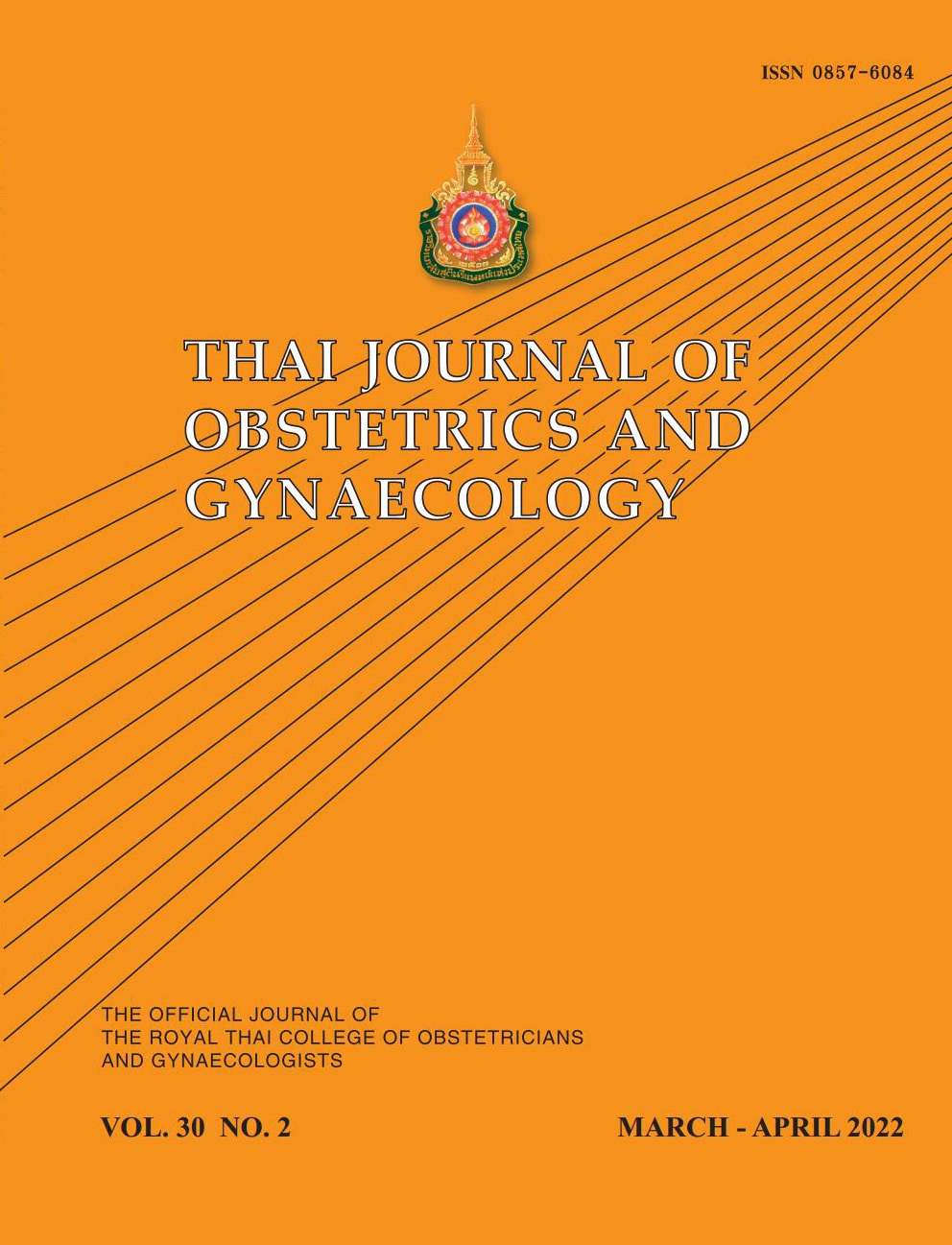Urinary Incontinence: Women Attending the Gynecology Outpatient Clinic Unaware of Symptoms
Main Article Content
Abstract
Objectives: To determine the prevalence, symptom characteristics, risk factors and impacts on quality of life (QoL) of urinary incontinence (UI) in Thai women attending a gynecology outpatient clinic.
Materials and Methods: Voluntary female participants attending a gynecologic outpatient clinic with a complaint of gynecologic problems but not of urinary incontinence at a medical university hospital were prospectively recruited during June 2019 and January 2020. The data were collected using self-reported questionnaires. A Urogenital Distress Inventory Short Form (UDI-6) and Incontinence Impact Questionnaire-Short Form (IIQ-7) in the Thai-version were used.
Results: The total of 354 participants were enrolled. One hundred and eighty-six women (52.5%) with gynecologic symptoms had experienced urinary incontinence during the past 3 months. The prevalence of urinary incontinence increased with age, vaginal delivery, and body mass index (BMI). Stress urinary incontinence (45.2%), urgency urinary incontinence (22.0%) and mixed urinary incontinence (32.8%) were reported among unrecognized urinary incontinence participants. A high BMI and constipation were found to be the significant factors associated with developing urinary incontinence. The QoL assessment from the IIQ-7 revealed that the women in the unaware group suffered a mild impact on UI from four domains of influence including physical activity, travel, social/relationships and emotional health of QoL.
Conclusion: Urinary incontinence was commonly found in Thai women attending a gynecology outpatient clinic. Despite experiencing the symptoms, however, the majority of them rarely sought treatment. This may be due to its mild symptoms.
Article Details

This work is licensed under a Creative Commons Attribution-NonCommercial-NoDerivatives 4.0 International License.
References
Abrams P, Cardozo L, Fall M, Griffiths D, Rosier P, Ulmsten U, et al. The standardisation of terminology in lower urinary tract function: report from the standardisation sub-committee of the International Continence Society. Urology 2003;61:37-49.
Minassian VA, Stewart WF, Wood GC. Urinary incontinence in women: variation in prevalence estimates and risk factors. Obstet Gynecol 2008;111:324-31.
Elbiss HM, Osman N, Hammad FT. Social impact and healthcare-seeking behavior among women with urinary incontinence in the United Arab Emirates. Int J Gynaecol Obstet 2013;122:136-9.
Kinchen KS, Lee J, Fireman B, Hunkeler E, Nehemiah JL, Curtice TG. The prevalence, burden, and treatment of urinary incontinence among women in a managed care plan. J Womens Health 2007;16:415-22.
Ju CC, Swan LK, Merriman A, Choon TE, Viegas O. Urinary incontinence among the elderly people of Singapore. Age Ageing 1991;20:262-6.
Manonai J, Poowapirom A, Kittipiboon S, Patrachai S, Udomsubpayakul U, Chittacharoen A. Female urinary incontinence: a cross-sectional study from a Thai rural area. Int Urogynecol J Pelvic Floor Dysfunct 2006;17:321-5.
Tsai Y-C, Liu C-H. Urinary incontinence among Taiwanese women: an outpatient study of prevalence, comorbidity, risk factors, and quality of life. Int Urol Nephrol 2009;41:795-803.
Lukacz ES, Santiago-Lastra Y, Albo ME, Brubaker L. Urinary incontinence in women: a review. JAMA 2017;318:1592-604.
Hsieh C-H, Su T-H, Chang S-T, Lin S-H, Lee M-C, Lee MY. Prevalence of and attitude toward urinary incontinence in postmenopausal women. Int J Gynaecol Obstet 2008;100:171-4.
Perera J, Kirthinanda DS, Wijeratne S, Wickramarachchi TK. Descriptive cross sectional study on prevalence, perceptions, predisposing factors and health seeking behaviour of women with stress urinary incontinence. BMC Womens Health 2014;14:78.
Luo R, Dai W, Tay LH, Ng FC, Koh L-T. Urinary incontinence in female outpatients in Singapore. Int Urogynecol J2018;29:579-84.
Cetinel B, Demirkesen O, Tarcan T, Yalcin O, Kocak T, Senocak M, et al. Hidden female urinary incontinence in urology and obstetrics and gynecology outpatient clinics in Turkey: what are the determinants of bothersome urinary incontinence and help-seeking behavior? Int Urogynecol J Pelvic Floor Dysfunct 2007;18:659-64.
Weerasopone S, Santingamkul A. Validation of the Thai version of the incontinence impact questionnaire (IIQ-7) and the urogenital distress inventory (UDI-6). Chulalongkorn Med J 2016;60:389-98.
Haylen BT, de Ridder D, Freeman RM, Swift SE, Berghmans B, Lee J, et al. An International Urogynecological Association (IUGA)/International Continence Society (ICS) joint report on the terminology for female pelvic floor dysfunction. Int Urogynecology J 2010;21:5-26.
Xu C, Chen M, Fu J, Meng Y, Qin S, Luo Y. Urinary incontinence status and risk factors in women aged 50-70 years: a cross-sectional study in Hunan, China. Int Urogynecol J 2021;32:95-102
Bunyavejchevin S. Risk factors of female urinary incontinence and overactive bladder in Thai postmenopausal women. J Med Assoc Thai 2005;88 (Suppl 4):S119-123.
Jueng-Anuwat P, Roongruangsilp U, Kochakarn W, Ratana-Olarn K. Risk factors for stress urinary incontinence in middle aged and elderly Thai women. J Med Assoc Thai 2001;84:1121-5.
Sakondhavat C, Choosuwan C, Kaewrudee S, Soontrapa S, Louanka K. Prevalence and risk factors of urinary incontinence in Khon Kaen menopausal women. J Med Assoc Thai 2007;90:2553-8.
Cooper J, Annappa M, Quigley A, Dracocardos D, Bondili A, Mallen C. Prevalence of female urinary incontinence and its impact on quality of life in a cluster population in the United Kingdom (UK): a community survey. Prim Health Care Res Dev 2015;16:377–82.
Bunyavejchevin S. The impact of overactive bladder, stress and mixed urinary incontinence on quality of life in Thai postmenopausal women. J Med Assoc Thai 2006;89:294-8.
Committee on Practice Bulletins. ACOG Practice Bulletin No. 155: Urinary incontinence in women. Obstet Gynecol 2015;126:e66-81.


